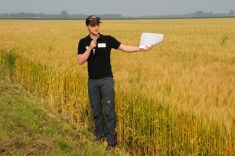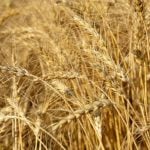Ducks Unlimited Canada trials have shown that nitrification and urease inhibitors are effective at reducing N2O emissions in winter wheat.
“The cool thing about it is, as soon as you add any form of inhibitor, you’re pretty much reaching that 30 per cent reduction in N20 emissions right off the hop,” said DUC winter wheat specialist Alex Griffiths. “We don’t need to cut our nitrogen rates by 30 per cent. You can just apply an inhibitor, and you’re probably going to be good.”
Griffiths is referring to the federal government’s target for a 30 per cent reduction in nitrous oxide emissions on farms by 2030.
Read Also

Better data on fertilizer emissions with the Internet of Things
Web of soil sensors looks for live insights on farm greenhouse gas emissions and nitrogen fertilizer application.
DUC has been providing incentives for farmers to seed winter wheat because ducks, particularly pintails, like the sparse cover around their nests that the crop provides in spring. So, the impetus for the trial was to tie the N2O reduction target to the work they’re already doing.
The trials are being run at all of the province’s crop diversification centres, and Griffiths spoke at the crop diversification day at Prairies East Sustainable Agriculture Initiative on July 31.
The trial tests five treatments. The first is an untreated check that only uses soil nitrogen. The next treatment is 100 per cent urea applied in the fall in a mid-row band that is untreated with an inhibitor.
This treatment had the highest emissions, said Griffiths. “So you have the goalposts set.”
The other three all have some form of inhibitor. The first is 60 per cent of the urea applied at seeding in a mid-row band, untreated, and 40 per cent applied broadcast urea with Agrotain. The second treatment uses the same 60/40 split, but instead of urea, uses 28 UAN — basically the liquid versus the granular form. The last one is 100 per cent fall-applied broadcast Super U, which has both nitrification and urease inhibitors.
At Arborg, the N2O emissions aligned closely with what was expected. The check was the low emitter; the 100 per cent urea with no inhibitor was the high emitter. However, emissions from the other three were almost identical.
“Basically, as soon as you put any form of inhibitor, whether it’s Agrotain or Super U, you’re seeing a huge reduction in your N2O emissions,” said Griffiths.
However, some differences were observed at the other sites.
“I was looking at the graphs of data that they had at Melita; the check is the lowest emitter, but the second lowest emitter is the 60 per cent fall-applied urea with the 40 per cent spring-applied urea with the Agrotain inhibitor.”
Once he noticed that, Griffiths looked at all the sites and discovered that at three of them, that treatment showed significantly less N2O emissions than the one treated with UAN.
“It seems like the liquid form might be a little bit more volatile, and as a result, you get more nitrous oxide emissions than the granular.”
Griffiths said they haven’t looked at cost of production for the various types of fertilizer used, but he is curious whether there will be any yield difference between application types.
“I don’t think it’ll be that much of a difference, because they’re all getting the same amount of total pounds of nitrogen. But if there is something significant, then you can find out pretty quickly what your costs are.”
Updated Aug. 20 – Corrects that the 100 per cent urea treatment that was applied in the fall in a mid-row band and was untreated with an inhibitor was the highest emitter, not highest yielder as initially stated.
















